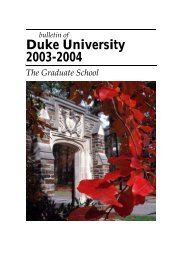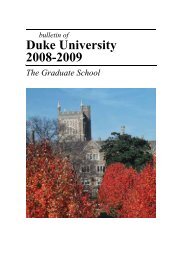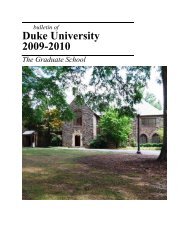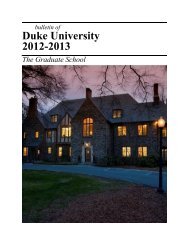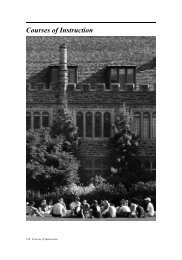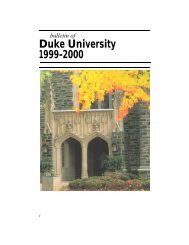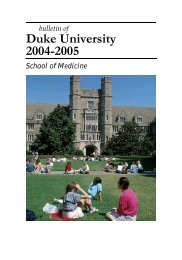2005-06 - Office of the Registrar - Duke University
2005-06 - Office of the Registrar - Duke University
2005-06 - Office of the Registrar - Duke University
You also want an ePaper? Increase the reach of your titles
YUMPU automatically turns print PDFs into web optimized ePapers that Google loves.
magnetic resonance, and problem-solving approaches. 1 to 4 units. Instructor: Staff.<br />
Variable credit.<br />
311. Biological Chemistry. Chemistry <strong>of</strong> <strong>the</strong> major classes <strong>of</strong> biological molecules,<br />
including nucleic acids, amino acids and proteins, carbohydrates and lipids. Topics include<br />
structure, reactivity and syn<strong>the</strong>sis, and <strong>the</strong> interaction <strong>of</strong> biological molecules. Instructors:<br />
Shaw and Toone. 4 units.<br />
312. Chemistry and Biology <strong>of</strong> Nucleosides, Nucleotides, and Nucleic Acids. Syn<strong>the</strong>sis,<br />
biosyn<strong>the</strong>sis, and reactivity <strong>of</strong> nucleic acids and <strong>the</strong>ir polymers. Mechanisms <strong>of</strong> DNA and<br />
RNA coding, decoding, transmission, and in vitro evolution. Covalent and reversible<br />
interactions <strong>of</strong> nucleic acids with small molecules and macromolecules. Instructors: Pirrung,<br />
Shaw and Toone. 4 units.<br />
314. Chemical Genomics. Information transfer, restructuring, and decoding in biological<br />
systems. Gene expression and evolution <strong>of</strong> function. Functional consequences <strong>of</strong> gene<br />
expression. Instructors: Shaw and Toone. Variable credit.<br />
316. Techniques in Biochemistry. Purification and study <strong>of</strong> biological molecules including<br />
macromolecules. Chromatography, spectroscopy (IR, UV/vis, fluorescence, CD),<br />
electrophoretic methods, immunological methods, analytical ultracentrifugation, and <strong>the</strong>ir<br />
application to <strong>the</strong> study <strong>of</strong> biomolecules. Instructors: Fitzgerald, Shaw, and Toone. 2 units.<br />
319. Special Topics in Biological Chemistry. Advanced topics and recent developments<br />
in biological chemistry. 1 to 4 units. Instructor: Staff. Variable credit.<br />
320. Physical Methods in Inorganic Chemistry. Physical methods covered include<br />
paramagnetic NMR, EPR, magnetism, NQR, Mossbauer spectroscopy, photoelectron<br />
spectroscopy, and x-ray analysis. Instructor: Palmer. 2 units.<br />
321. Inorganic Chemistry. Bonding and spectroscopy, reactions, transition metal<br />
chemistry, main group chemistry, organometallics/catalysis, and solid state. Instructors:<br />
Crumbliss, Franz, and Palmer. 4 units.<br />
322. Chemical Applications <strong>of</strong> Group Theory Including Spectroscopy. Topics covered<br />
include symmetry, point groups, group <strong>the</strong>ory, character tables, electronic absorption<br />
spectroscopy, infrared spectroscopy, Raman spectroscopy, and microwave spectroscopy.<br />
Instructors: Palmer and Simon. 2 units.<br />
324. Bioinorganic Chemistry. Topics covered include metal activated enzymes in<br />
hydrolysis, oxygencarriers, nitrogen fixation, iron storage and transport, photosyn<strong>the</strong>sis,<br />
protein electron transfer, and DNA mediated electron transfer. Instructors: Crumbliss and<br />
Franz. 2 units.<br />
326. Inorganic Reaction Mechanisms. A discussion <strong>of</strong> <strong>the</strong> mechanism <strong>of</strong> coordination<br />
reactions in solution. Examples include redox reactions and linear free energy relationships.<br />
Instructor: Crumbliss. 2 units.<br />
328. Syn<strong>the</strong>sis and Syn<strong>the</strong>tic Methods in Inorganic/Organometallic Chemistry. A<br />
discussion <strong>of</strong> inorganic syn<strong>the</strong>tic methods including supramolecular chemistry and<br />
organometallic reactions. Instructor: Widenhoefer. 2 units.<br />
329. Special Topics in Inorganic Chemistry. Lectures, oral reports, and discussions on<br />
advanced topics and recent advances in <strong>the</strong> field <strong>of</strong> inorganic chemistry. Topics may include:<br />
bioinorganic chemistry, fluxional molecules, homogeneous catalysis, syn<strong>the</strong>sis and<br />
properties <strong>of</strong> selected groups <strong>of</strong> compounds, and new physical methods. 1 to 4 units.<br />
Instructor: Staff. Variable credit.<br />
331. Organic Chemistry. Bonding and structure, stereochemistry, conformational analysis,<br />
substitution, addition, and elimination reactions, carbon reactive intermediates, concerted<br />
reactions, photochemistry, carbon alkylation, carbonyl addition nucleophilic substitution,<br />
electrophilic additions, reduction, cycloadditions, rearrangements, main group<br />
organometallics, oxidation. Instructors: Baldwin, Coltart, Craig, Toone, and Widenhoefer.<br />
4 units.<br />
Chemistry (CHEM) 95



